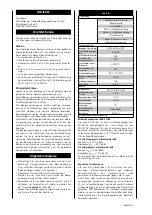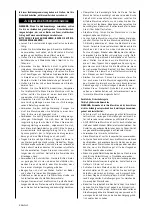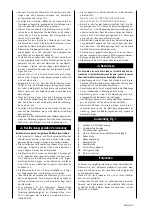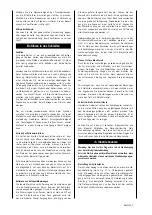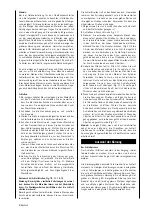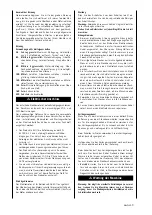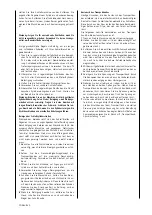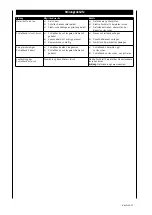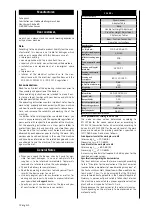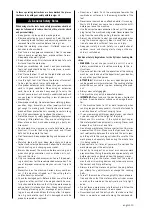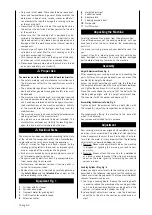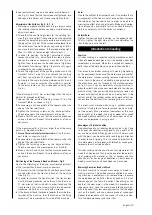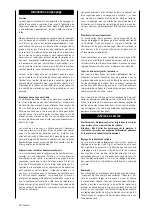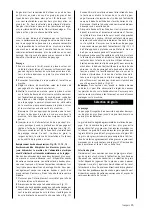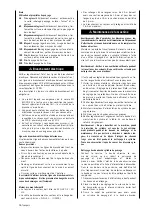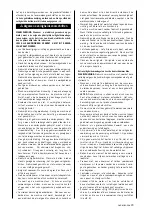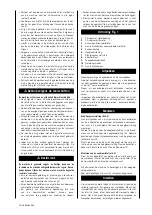
16 english
Do not be surprised at how thin the wood is, after all of
the warps have been removed.
Ridges and bends in the wood can not be removed from
wood with a cylinder-sanding machine -- and not with a
planing machine either, of course. Before starting sand-
ing, check the wood for ridges and bends, because these
can easily be caught in the machine. Short pieces of wood
are particularly difficult in this aspect.
Plane Your Work Piece First
Planing reduces the time you will need for adjustment
and sanding and also the operator‘s level of frustration.
Sort your work pieces according to their thickness and
the coarseness of sandpaper that needs to be used. Begin
with the thickest material and work through to the thin-
nest. Then change to the next, finer grade of, sandpaper
and begin the procedure again.
We suggest that you experiment with various coarsenesses
and kinds of wood to find out what kind of results you can
achieve before you ruin a piece of wood. When new adjust-
ments to the machine are made, be sure to make a test
run with scrap material before beginning work.
Kinds of Wood That Require Caution
Wood that has a large amount of resin can quickly clog the
sanding paper and in many cases, the material that col-
lects cannot be removed with the belt cleaning brushes.
This is particularly often the case with some kinds of pine.
It is almost impossible to free the sanding belt from the
combination of sap and sawdust.
Use care with those kinds of woods with poisonous char-
acteristics, such as members of the tulipwood family. In
spite of dust-suction, small particles can be breathed in
with the room air and cause allergic reactions. For extra
protection, wear a mask and gloves when working with this
kind of wood.
Start Up
Warning: Never put your fingers in the dust exhaust or un-
der the cylinder cover.
Attention: In order to avoid damage to your machine, dur-
ing operation an adequate dust-suction mechanism must
be attached.
Adjustment of the Cylinder Height
The cylinder moves slightly upwards, if the height ad-
justment (see Fig. 2) is turned in a clockwise direction.
It moves downwards, if the height adjustment is turned
in a counter clockwise direction. A movement of 0.4 mm
corresponds roughly to a quarter turn in each direction.
A complete turn thus corresponds to 1.6 mm. The depth
adjustment can be read on the scale on the right side of
the cylinder frame.
Please note:
When adjusting the depth for the surface sanding, the fol-
lowing variables should be taken into account: material
hardness, width of the work piece and the selected intake
speed. All these criteria are to be considered, in order to
calculate the amount of material to be removed on each
through pass. Never remove more than 0.8 mm on a sin-
gle pass. The variable intake speed is adjusted in order to
avoid burning and to produce a smoothly sanded surface
in various kinds of wood and for different widths.
As a general rule, a quarter turn or 0.4 mm or less for
coarser sandpaper and softer kinds of wood is recommend-
ed, while an eighth of a turn or 0.2 mm is recommended
for harder woods and/or finer paper. When determining
the intake speed for the material to be sanded, the rule
is that the broader the material is the slower the selected
intake speed should be. Equally, the intake speed should
be slower for harder types of wood.
A certain amount of experimentation and practice is need-
ed in order to become confident with the sanding perform-
ance of your machine. While surface sanding is similar to
surface preparation with a planing machine, the planing
machine, due to its special type of cutting edges, remove
much more material with each pass. The sanding ma-
chine, on the other hand, removes a limited amount of
material with the sanding medium.
Sanding
1 While the machine is still turned off, place the work
piece on the entry table and push it so far forward that
the height of the cylinder can be adjusted. This means
the wood is to be positioned so that a uniform thickness
is attained at the highest point of the work piece.
2 Close the dust-suction unit and turn this on.
3 Adjust the entry speed, according to the sanding re-
quirements and the width of the materials.
4 Turn the machine on, place the work piece on the trans-
port table and let the cylinder start sanding. Support a
long work piece while it is being sanded, if necessary.
As soon as the sanding process allows, move to the exit
side of the machine, in order to catch the wood and to
support it as it leaves the machine.
Note: Do not put any pressure on from the top or the
bottom, when leading the work piece through the ma-
chine. If you do, you may leave marks on the sanded
wood.
5 If the wood is passed through the machine several
times, turn it around, while you adjust the depth of
sanding with the handle (see Fig. 2). There are many
variables that influence the depth chosen for sanding.
These include the choice of sandpaper grain, the width
of the wood, intake speed and the moisture content of
the work piece.
Replacing the Sanding Belt, Fig. 10, 11, 12, 13
Warning: in order to avoid serious injury, always unplug the
machine before doing any maintenance work or changing the
sanding belts.
Pre-sized sanding belts, which do not require any meas-
urement or cutting, can be bought from your dealer. These
belts are conically shaped at the end. They are radially
wrapped round the cylinder to create an endless strip. You
can also cut your own belts to the correct size from a large
roll. To do this, use the belts included in the delivery as
a pattern.
1 Make sure that the switch is on OFF and the plug is
pulled out.
2 Fig. 10 shows the sanding belt pattern.
3 Take either a pre-cut or a self-cut belt and begin the
installation by putting the conical point in the slit on
the left side of the cylinder while pushing the clip down
(Fig. 11). Roughly, 25 mm of the material should be
put into the slit, in order to connect it to the sanding
clip. Release the clip, once the conical end is positioned
firmly in the clip back. Note: You can use the worn out
belts as a pattern to cut new belts.


